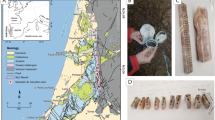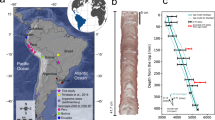Abstract
We report here detailed evidence that during the period 1600–1100 BC the geomagnetic intensity in Egypt and western Asia increased monotonically by a factor of 1.6 and propose that, within this region and this period, such intensity can be used as a dating tool. The results, which form the reference data for age evaluation, are from well-dated archaeological samples of baked clay from Cyprus, Egypt, Israel and Mesopotamia using a version of the Thellier technique1 as modified for use in a cryogenic (SQUID) magnetometer2. There is no evidence for the more rapid fluctuations that have been reported for Egypt3, Greece4 and France5 during this and other periods. Earlier than 1700 BC the intensity remains close to the present-day level, although there is some indication of a small fluctuation.
This is a preview of subscription content, access via your institution
Access options
Subscribe to this journal
Receive 51 print issues and online access
$199.00 per year
only $3.90 per issue
Buy this article
- Purchase on Springer Link
- Instant access to full article PDF
Prices may be subject to local taxes which are calculated during checkout
Similar content being viewed by others
References
Thellier, E. & Thellier, O. Ann. Geophys. 15, 285–376 (1959).
Walton, D. Archaeometry 19, 192–200 (1977).
Games, K. P., Geophys. J.R. astr. Soc. 63, 45–56 (1980).
Walton, D. Nature 277, 643–644 (1979).
Shaw, J. Geophys. J.R. astr. Soc. 58, 107–116 (1979).
Walker, C. F. C. Cuneiform Brick Inscriptions in the British Museum. The Ashmolean Museum. Oxford (British Museum Publ. No. 71, 1981).
Macadam, F. L. Corpus of Egyptian Funerary Cones (Oxford University Press, 1957).
Brinkman, J. A. in Ancient Mesopotamia (by Oppenheim, A. L.) 335–348 (University of Chicago Press, 1977).
Aitken, M. J., Alcock, P. A., Bussell, G. D. & Shaw, C. J. Archaeometry 23, 53–64 (1981).
Aitken, M. J., Alcock, P. A., Bussell, G. D. & Shaw, C. J. in Geomagnetism of Baked Clays and Recent Sediments (eds Creer, K. M., Tucholka, P. & Barton, C. E.) 122–127 (Elsevier, Amsterdam, 1983).
Fox, J. M. W. & Aitken, M. J. Nature 283, 462–463 (1980).
Barton, C. E., Merril, R. T. & Barbetti, M. Phys. Earth planet. Inter. 20, 96–110 (1979).
Baines, J. & Malek, J. Atlas of Ancient Egypt (Phaidon, London, 1980).
Author information
Authors and Affiliations
Rights and permissions
About this article
Cite this article
Aitken, M., Allsop, A., Bussell, G. et al. Geomagnetic intensity in Egypt and western Asia during the second millennium BC. Nature 310, 305–306 (1984). https://doi.org/10.1038/310305a0
Received:
Accepted:
Issue Date:
DOI: https://doi.org/10.1038/310305a0
This article is cited by
-
Improvement of the secular variation curve of the geomagnetic field in Egypt during the last 6000 years
Earth, Planets and Space (1999)
-
Greek archaeomagnitudes
Nature (1985)
Comments
By submitting a comment you agree to abide by our Terms and Community Guidelines. If you find something abusive or that does not comply with our terms or guidelines please flag it as inappropriate.



